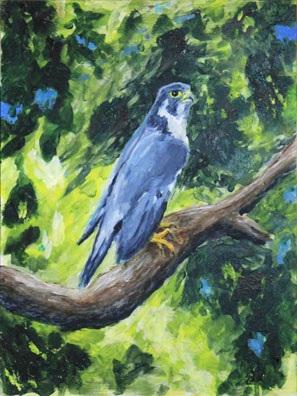Peregrine Falcon

First of all, peregrine falcons - Falco peregrinus to the eggheads - are big. The males are between 15 and 18 inches long and the females are, yes, even larger at 18 to 20 inches. This characteristic - the ladies being bigger than the gentlemen - is common among birds of prey.
But what might grab your attention if you see one in action is the wingspan. It is - no fooling - between 3 and 3½ feet. That's a pretty big bird.
The peregrines range from the tundra in the Arctic to the tropics of Africa and Asia and even to islands in the Pacific Ocean. They usually nest on steep cliffs - or as increasingly common today on tall buildings. They shy away from forests since they use their eyes - which are far better than humans - to spy their prey on the ground. A peregrine falcon can spot its prey from as far away as five miles.
Peregrines are not only big but they're fast. Their top speed is probably around 150 miles per hour - although you will read they might hit near 200 mph. But 150 miles an hour is still pretty darn fast.
There are few natural predators that the peregrines have to worry about. But their food is almost entirely of other birds. They tend to avoid critters like rats and mice but will eat them in a pinch. Usually they prefer birds a bit smaller than themselves, but they have been known to catch herons.
At one time, peregrines were endangered but have had a strong rebound and in some places are more numerous than before. They also happen to be a favorite bird by falconers - the guys and gals who wear the thick leather gloves and use the birds to hunt anything from small critters to bugs.
Falconry, of course, was a popular sport for kings of the Middle Ages. Probably one of the most enthusiastic falconer in history was Henry VIII of England who seems to have spent a lot of his time goofing off since he had plenty of people to do the real work for him - at least he did while they lasted.
References
Animals Under Threat: Peregrine Falcon, Mike Unwin, Capstone Classroom, 2004.
"Peregrine Falcon", National Geographic.